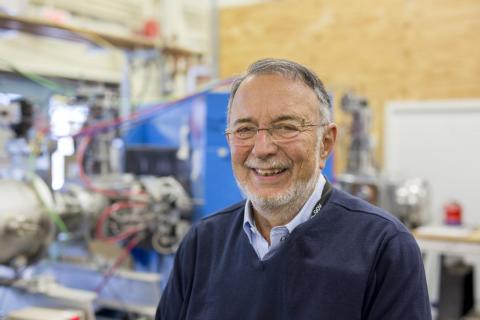
Dr. John D’Auria is a chemist in a physicist’s world, with a long track record of profound dedication to the pursuit of excellence in science. A professor at SFU since 1968, John is one of the masterminds behind TRIUMF’s ISAC (Isotope Separator and Accelerator) facilities. After decades of exceptional contributions to the physics community, John D’Auria has been invited to be a Fellow of the American Physical Society, the world’s largest association of physicists.
“A brash New Yorker in Canadian clothes,” is how Dr. Richard Casten, D. A. Bromley Professor of Physics at Yale and a long time colleague and friend of D’Auria’s, describes him. “He is driven to discover the unknown,” Casten adds. “John pushes buttons in the control room and within the science community. He’s a rebel who has changed the landscape of science and will get the job done well.”
After D’Auria earned his Ph.D. with his studies centered on the Heavy Ion Accelerator at Yale University, in 1968 he relocated to Canada to take up a post as Professor in Nuclear Chemistry at the then new Simon Fraser University (SFU) - coincidentally the same year TRIUMF was initially funded. SFU was one of the three original member universities of TRIUMF and D’Auria and his colleagues were key players in this. In fact, D’Auria was involved in experiment number three at TRIUMF, “The Study of Fragments Emitted in Nuclear Reactions.” It wasn’t long before D’Auria began tinkering with a bigger idea.
During APS’s Division of Nuclear Physics conference in 1989, alongside other scientists, John promoted the idea of using radioactive beams for the study of exotic nuclei. “Today, we all think of this as a major field of study in nuclear physics,” says Casten, but without D’Auria’s’s persistence he “dreads to think where this major field of science would be now without him.” In pursuit of exotic nuclei, D’Auria became the principal investigator on TISOL (TRIUMF test Isotope On-Line facility), an ion-beam transport and isotope separator system based on a similar project D’Auria worked on while on sabbatical at CERN. Eventually, D’Auria headed the TISOL project and its construction.
TISOL was conceived as a niche project but turned into a big hit for TRIUMF; successful experiments were abundant. “Some were so successful that we could walk down the middle of the corridor instead of the sides of the corridor, you know, like football players in highschool. We were accepted as a real physics experiment,” says D’Auria.
In particular the “Red Giant” experiment demonstrated the importance of using exotic rare isotopes for nuclear astrophysics by using beta-delayed alpha emission from N-16 to determine one component 12C(α, γ)16O reaction rate at stellar energies. “That reaction takes place in stars and it’s where the carbon in your body came from, where the oxygen you are breathing in comes from,” says D’Auria. TISOL became the catalyst that led TRIUMF into a new era of physics with the introduction of the ISAC facilities in the late 1990’s.
TRIUMF management approved ISAC’s proposal during the 1995–2000 Five-Year Plan and eventually broke ground in 1995. D’Auria served as an advisor during this time and also co-leader of the DRAGON (Detector of Recoils And Gammas Of Nuclear reactions) facility. The DRAGON experiment was “the first new major experiment on the ISAC floor that was successful,” says D’Auria.
With DRAGON, D’Auria and his team were able to combine the high intensity radioactive beams from ISAC. To accompany DRAGON, the ISAC team built a low-energy accelerator chain to select the right energies to match the velocities of ions in stars. Then they used DRAGON to do measurements of the reaction of the accelerated radioactive beam with a hydrogen target. “ISAC is the only place in the world that can do that–still!” says D’Auria.
D’Auria’s dedication to science has never been questioned. Casten recalls the early days of fleshing out a long White Paper on the ISL (IsoSpinLab) with extremely long days, and when it would come time to stop for the evening, no one “least of all John, wanted to stop.” He was “tenacious, dedicated, and determined.”
It is that determination for excellence in science that has lead to his American Physical Society Fellow invitation, which is based on the criteria for exceptional contributions to the physics enterprise.
Casten recalls, “It was John’s relentless efforts, which all started from a minor beam line and has turned into everything that it is today. Much of the time he was swimming upstream but that never daunted him.” After decades of success, the one thing we can learn from John is that, “he was right about it all from the get-go.”
Nic Zdunich, Communications Assistant
